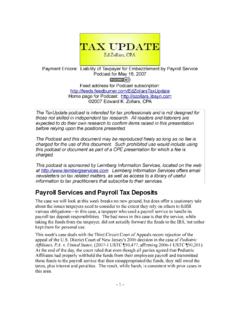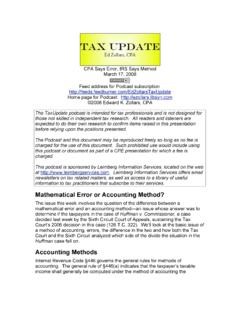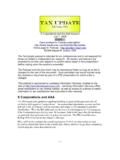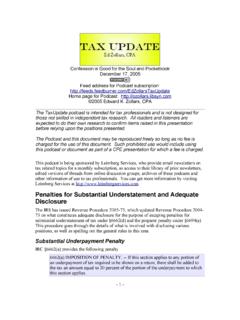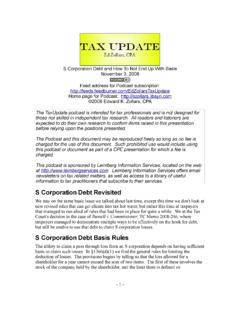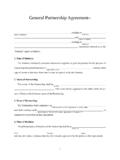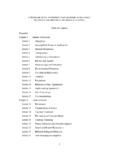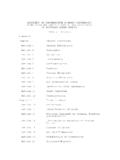Transcription of The IRS Goes After Partnership Liquidation …
1 Economic Substance, Promissory Notes and Partnerships January 14, 2008. Feed address for Podcast subscription: Home page for Podcast: 2008 Edward K. Zollars, CPA. The TaxUpdate podcast is intended for tax professionals and is not designed for those not skilled in independent tax research. All readers and listeners are expected to do their own research to confirm items raised in this presentation before relying upon the positions presented. The Podcast and this document may be reproduced freely so long as no fee is charged for the use of this document. Such prohibited use would include using this podcast or document as part of a CPE presentation for which a fee is charged. This podcast is sponsored by Leimberg Information Services, located on the web at Leimberg Information Services offers email newsletters on tax related matters, as well as access to a library of useful information to tax practitioners that subscribe to their services.
2 The IRS goes After Partnership Liquidation Transaction In the case of Countryside Limited Partnership v. Commissioner, TC Memo 2008-3, the IRS attempted to apply the general concepts of economic substance, the specific anti-abuse Partnership provisions found in Reg. 2 and (h) and a claimed side agreement that, in the IRS's view, changed promissory notes into marketable securities per 731(c)(1)(B) to impose tax on a Partnership interest redemption that the taxpayers contended resulted in no recognized gain per the general provisions of 731(a). The IRS was unsuccessful on all counts, and the case provides some interesting insights into the application of the various provisions regarding tax motivated transactions and Partnership Liquidation provisions. -1- Economic Substance, Promissory Notes and Partnerships Podcast of January 14, 2008. Feed Partnership Distribution Provisions The general rules for taxation of a distribution to a partner is governed by 731, which provides at its beginning: (a) Partners In the case of a distribution by a Partnership to a partner-- (1) gain shall not be recognized to such partner, except to the extent that any money distributed exceeds the adjusted basis of such partner's interest in the Partnership immediately before the distribution, and At first glance that rule appears very simple we look to see if a taxpayer received cash and, if not, we have no gain issue.
3 But, as is often true, the Code complicates matters with a couple of definitional issues that tell us that money . isn't necessarily limited to what we generally think of as money. Of key importance generally for Partnership taxation is the overriding rule of 752 that establishes a definition that ties debt to money for these purposes. For distributions, a key provision is 752(b) which provides: (b) Decrease in partner's liabilities Any decrease in a partner's share of the liabilities of a Partnership , or any decrease in a partner's individual liabilities by reason of the assumption by the Partnership of such individual liabilities, shall be considered as a distribution of money to the partner by the Partnership . In addition, 731(c) provides an expansion of the defintion of cash to include marketable securities in most cases: (c) Treatment of marketable securities (1) In general For purposes of subsection (a)(1) and section 737-- (A) the term "money" includes marketable securities, and (B) such securities shall be taken into account at their fair market value as of the date of the distribution.
4 And, to continue, our definition of what is marketable securities also isn't quite so simple. A provision will come into play in this case is a special expansion of the definition of marketable securities found at 731(c)(2)(B)(ii) that provides for these purposes that marketable securities will include: (ii) any financial instrument which, pursuant to its terms or any other arrangement, is readily convertible into, or exchangeable for, money or marketable securities, -2- Economic Substance, Promissory Notes and Partnerships Podcast of January 14, 2008. Feed But even transactions that literally comply with the Code and regulations may run afoul of various anti-abuse rules in the Partnership regulations. Reg. provides a broad set of anti-abuse rules where transactions are structured to avoid the intent of Subchapter K. Reg. (b) specifically provides: (b) Application of subchapter K rules.
5 The provisions of subchapter K and the regulations thereunder must be applied in a manner that is consistent with the intent of subchapter K as set forth in paragraph (a) of this section (INTENT OF SUBCHAPTER K). Accordingly, if a Partnership is formed or availed of in connection with a transaction a principal purpose of which is to reduce substantially the present value of the partners' aggregate federal tax liability in a manner that is inconsistent with the intent of subchapter K, the Commissioner can recast the transaction for federal tax purposes, as appropriate to achieve tax results that are consistent with the intent of subchapter K, in light of the applicable statutory and regulatory provisions and the pertinent facts and circumstances. Thus, even though the transaction may fall within the literal words of a particular statutory or regulatory provision, the Commissioner can determine, based on the particular facts and circumstances, that to achieve tax results that are consistent with the intent of subchapter K -- (1) The purported Partnership should be disregarded in whole or in part, and the Partnership 's assets and activities should be considered, in whole or in part, to be owned and conducted, respectively, by one or more of its purported partners.
6 (2) One or more of the purported partners of the Partnership should not be treated as a partner;. (3) The methods of accounting used by the Partnership or a partner should be adjusted to reflect clearly the Partnership 's or the partner's income;. (4) The Partnership 's items of income, gain, loss, deduction, or credit should be reallocated; or (5) The claimed tax treatment should otherwise be adjusted or modified. Section 731(c) has its own specific anti-abuse provision in Reg. (h). which provides: (h) Anti-abuse rule. The provisions of section 731(c) and this section must be applied in a manner consistent with the purpose of section 731(c) and the substance -3- Economic Substance, Promissory Notes and Partnerships Podcast of January 14, 2008. Feed of the transaction. Accordingly, if a principal purpose of a transaction is to achieve a tax result that is inconsistent with the purpose of section 731(c).
7 And this section, the Commissioner can recast the transaction for Federal tax purposes as appropriate to achieve tax results that are consistent with the purpose of section 731(c) and this section. Whether a tax result is inconsistent with the purpose of section 731(c) and this section must be determined based on all the facts and circumstances. For example, under the provisions of this paragraph (h) -- (1) A change in Partnership allocations or distribution rights with respect to marketable securities may be treated as a distribution of the marketable securities subject to section 731(c) if the change in allocations or distribution rights is, in substance, a distribution of the securities;. (2) A distribution of substantially all of the assets of the Partnership other than marketable securities and money to some partners may also be treated as a distribution of marketable securities to the remaining partners if the distribution of the other property and the withdrawal of the other partners is, in substance, equivalent to a distribution of the securities to the remaining partners; and (3) The distribution of multiple properties to one or more partners at different times may also be treated as part of a single distribution if the distributions are part of a single plan of distribution.
8 Finally, the IRS has the ability to make use of the more general economic substance doctrine to remove tax benefits if the underlying transactions, taken as whole, do not have any economic substance that is, the only thing happening from an economic perspective is that taxes are being reduced. In this case, the IRS looks to the 1965 Second Circuit's affirmation of the Tax Court's holding in the case of Goldstein v. Commissioner, 364 734. In this case, the Tax Court summarizes the Goldstein facts as follows: In the Goldstein case, the taxpayer (Mrs. Goldstein, the wife in a joint return filing) won over $140,000 in the Irish Sweepstakes. In an effort to mitigate the tax impact of having to report all her winnings in the year of receipt, her advisers constructed a plan pursuant to which, before the end of that year, she borrowed $945,000 from two banks, purchased $1. million face amount Treasury notes, and prepaid 4 percent interest for years on one bank loan and for approximately years on the other.
9 The total interest prepayment was over $81,000, which the Goldsteins claimed as a deduction in the year of payment under section 163(a). We denied the deduction on the ground that "there was no genuine indebtedness established between * * * [Mrs. Goldstein] and * * *. [the banks]." Goldstein v. Commissioner, 44 at 298. The Court of -4- Economic Substance, Promissory Notes and Partnerships Podcast of January 14, 2008. Feed Appeals for the Second Circuit affirmed, but on a different basis. It agreed with the dissenting opinion in this Court that the bank loans were "'indistinguishable from any other legitimate loan transaction contracted for the purchase of Government securities'", Goldstein v. Commissioner, 364 at 737 (quoting Goldstein v. Commissioner, 44 at 301 (Fay, J., dissenting)), and it found that we were in error in concluding that those loans "were 'shams' which created no genuine indebtedness", id.
10 At 738. It agreed, however, with our finding that Mrs. Goldstein entered into the two bank loans "without any realistic expectation of economic profit and 'solely' in order to secure a large interest deduction * * * [to offset her sweepstakes winnings]." Id. at 740. The court found that Congress intended to limit interest deductions under section 163(a) to interest on debt incurred for "purposive activity", and it held that that section did not permit a deduction for the interest paid by Mrs. Goldstein where the sole purpose of her borrowings was to generate tax deductible interest. Id. at 740-742. Because Mrs. Goldstein could not profit from this transaction (it served merely to shift income into a later year), there was no substance to the transaction aside from accomplishing the goal of reducing taxes. That is true even though, as the Second Circuit effectively found, Mrs. Goldstein had complied with all the literal requirements of the law necessary to obtain the deduction.

